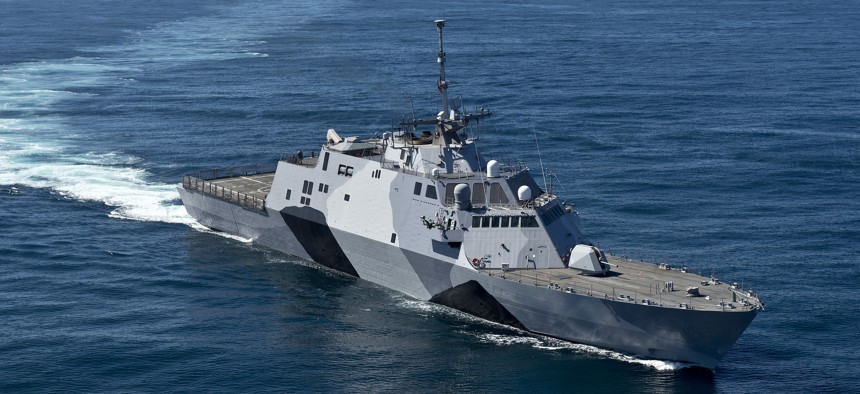
The littoral combat ship USS Freedom (LCS 1) is underway conducting sea trials off the coast of Southern California in 2013. U.S. Navy / Mass Communication Specialist 1st Class James R. Evans
Naysayers Are Learning the Wrong Lessons About the Littoral Combat Ship
The LCS is bringing needed numbers — and following the paths of very successful ship classes.
Recently, the distinguished national security practitioner and analyst Lawrence Korb, whom I hold in the highest professional regard, detailed four lessons from the saga of the Littoral Combat Ship for Defense One readers to consider. Leveraging history to inform policy is a preferred method of analysis and I was reminded of the opposing views regarding the Vietnam War. One side believed that the lesson was not to interfere in foreign civil wars, while the other concluded that the nation should never commit troops unless it was dedicated to victory. One war, two opposing lessons. Such is the case, it appears, with the Littoral Combat Ship, and it is with deep respect that I must challenge Dr. Korb’s assertions.
Dr. Korb proposed that the first lesson of the Littoral Combat Ship was that the Navy focused too much on the number of ships rather than on their capabilities. This was true, but it was also necessary. The Navy came out of the 1980s with a fleet of over 500 ships (592 in 1989) and made a pivot, as part of the Second Offset Strategy, to focus less on quantity and more on high-end capabilities such as the Aegis Mk-7 weapons system. We had a large fleet and could afford to ride the numbers down a bit — and if conflict ever did rear its ugly head, Congress would turn the spigot back on and the shipyards could begin pushing out ships. Except conflict did come (9/11), and the spigot did get turned back on (the Navy budget went up 25 percent between 2001 and 2012, from $122 billion to $161 billion) but the size of the fleet went down (316 ships down to 285). The budget increase actually went to pay for additional operations and maintenance costs while shipbuilding funds remained largely flat.
As the fleet shrunk (largely due to the decommissioning of aging and maintenance-intensive ships added during the Carter-Reagan era), and wartime operations tempo increased, ships and their crews began staying at sea longer. Deployments grew from six months to nine or even 12 to cover American maritime commitments. Maintenance issues grew commensurately. It was readily apparent that the Navy needed to enlarge its fleet in order to cover the 19 maritime regions in which the United States had defined strategic interests. In most cases, it takes five ships in the fleet to keep one forward deployed: one forward, one coming home, one heading out, one working up, and one in maintenance. Given how our fleet is organized and the various combatant commands’ stated requirements, careful calculations show that it would take a fleet of 350 to meet the nation’s needs. When the LCS was under consideration in the early 2000s, the fleet had 315 ships, but was trending lower. Navy leaders knew we needed to purchase a low-cost ship that could provide basic mission services — most importantly, naval presence — in large numbers to get the fleet’s numbers up under the flat shipbuilding budgets they were facing. Hence the LCS design. Most serious analysts had come to realize that sometimes capacity is a capability.
Dr. Korb’s second proposed lesson from the LCS experience was that the ship’s design came with flaws, notably the lengthy time required to install and remove mission modules. This is not the first time that a new design has faced challenges early in its life. The Oliver Hazard Perry frigates, originally conceived as subhunting convoy escorts, first deployed with an underwater sensor that was so bad that it was nicknamed the “Helen Keller” sonar. The Ticonderoga-class cruiser arrived so top-heavy that there was concern during sea trials that she would tip over. The first 27 Arleigh Burke-class destroyers, built without a helicopter hangar, have a diminished capacity to operate in submarine-infested waters.
But the Perrys’ operations were modified from anti-submarine to surface warfare support. The Ticonderogas were stabilized with ballast and later Burkes eventually got a helo hangar. All of these ships today are considered part of the “Golden Age” of ship design. Design evolution and hullform improvement is the rule, not the exception, and we are less than 10 ships into the fielding of the LCS.
Dr. Korb’s third lesson was that the ships were rushed into production before the designs were fully mature. As already stated, this is more the rule of ship operations and not the exception. As well, the fleet is currently down to 272 ships with nearly 40 percent of the fleet at sea at any given moment, deploying for seven to nine months at a time, then coming home to be rushed into the yards in vain attempts to get them back up to full capability before they have to be rushed back out on deployment again. Even with this extreme level of effort, critical maritime regions are being gapped, and rising powers are seeking to test the international norms and rule of law that the United States and established and built up over the past 70 years. The international system is eroding before our eyes.
Lastly, Dr. Korb raises the specter of LCS’s cost growth. I can only presume that he is referring to the growth from its original estimated cost of $250 million in 2001 ($337 million in 2016 dollars) to $550 million today, because the current price actually reflects a nearly 17-percent decrease from the cost of LCS 1 and 2 to the the ships that are now emerging from the shipyards in Wisconsin and Alabama today. More decreases are projected as production efficiencies are found and incorporated. Let’s start by saying that the $250 million LCS was a goal, as $800 million was the goal for the Arleigh Burke destroyers (delivered at $1.1 billion originally, now $2.2 billion). Some inflation accompanies nearly every class of ship over time, and the Littoral Combat Ship’s costs are slowly coming into line with other ships of similar design. However, it should be understood that if the LCS is to be improved to a true frigate’s capability, analogous to the Italian FREMM multipurpose frigate, some additional costs will be incurred. Ultimately, a ship in the $800-million range is affordable within the current budget mix and would still add numbers to the fleet.
I have high regard for Lawrence Korb’s contributions to our nation’s security, but in this case I must respectfully disagree with his analysis. The Second Offset emphasized capabilities over capacity and I fear that today’s present Third Offset may as well. It must be understood that sometimes numbers are what it is all about. The 2007 Cooperative Strategy for 21st Century Seapower made an important observation that seemed self-evident: that preserving the peace is at least as important as winning the nation’s wars. This seems easy to do, until it isn’t, and it isn’t now. The nation’s Navy has simply gotten too small to preserve the peace. Free navigation and free trade are being challenged with new views on expanded maritime “sovereignty” over portions of the high seas. Critical resources and fishing stocks are being exploited. Wherever the United States Navy is absent, the stable global maritime system is under assault. We need more ships now, and they cannot all be $15-billion aircraft carriers or even $2-billion destroyers. Often times all that is needed is a small gray hull with a white number, a good-sized gun and missile battery and a red, white, and blue flag that promises that more power is right behind it to maintain peace and stability. Given the fiscally constrained budgetary environment, we need an affordable fleet of 350 ships, with 75 of them being frigates. An expanded force of enhanced, robust Littoral Combat Ships will help our nation preserve the peace.
NEXT STORY: The Myth of American Disengagement




